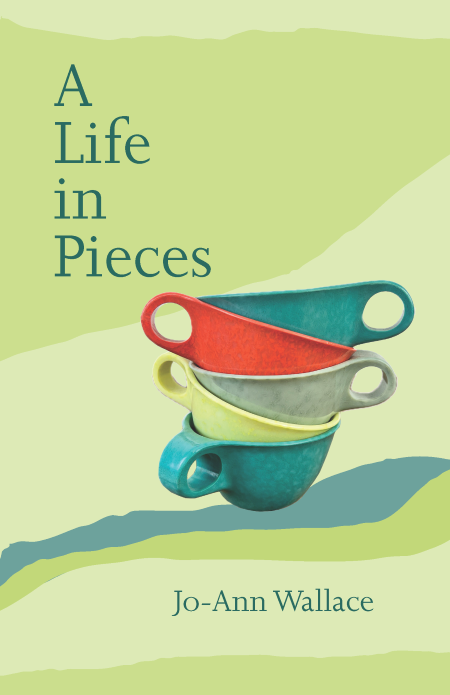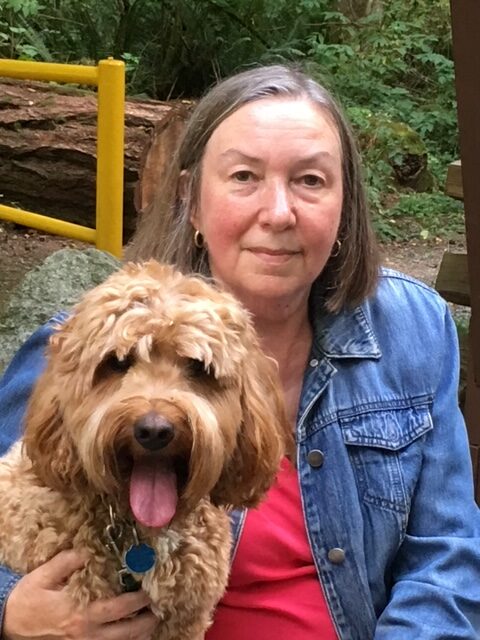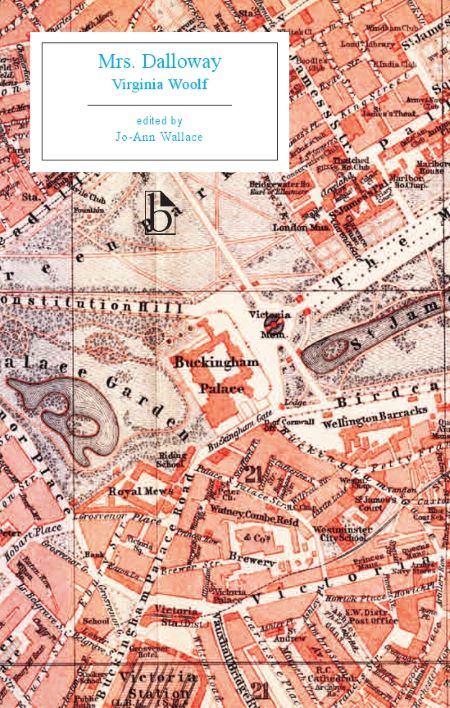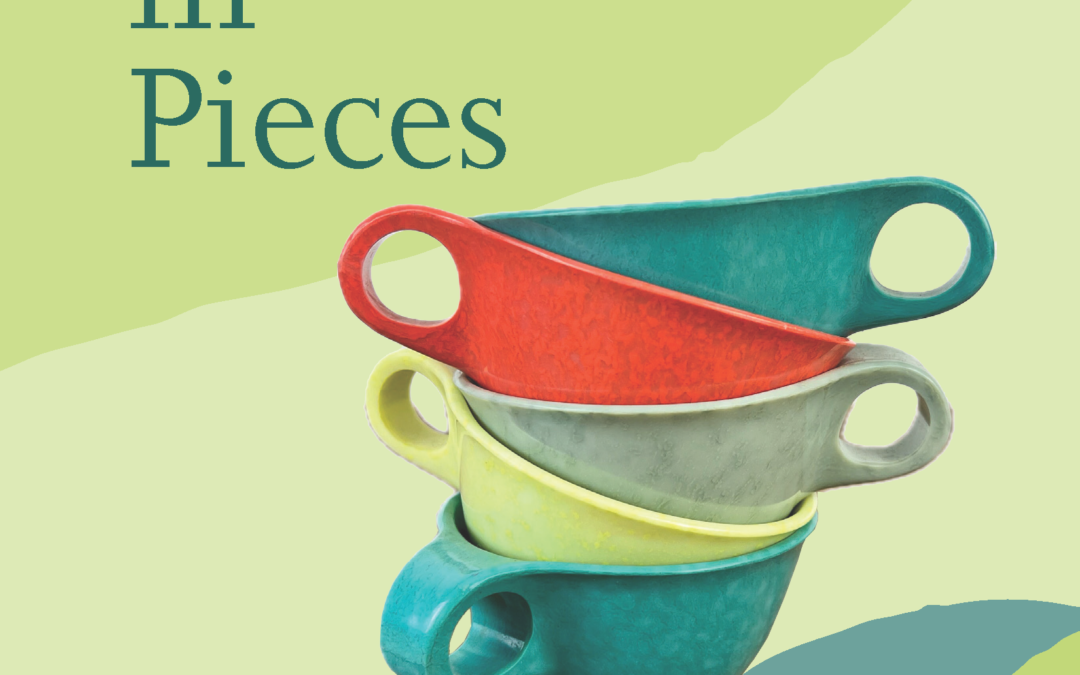 In one of her essays, “Virginia Woolf’s Commas” in the “Late” section of A Life in Pieces (Thistledown Press, 2024), Jo-Ann Wallace writes of typing Woolf’s Mrs. Dalloway “from beginning to end.”
In one of her essays, “Virginia Woolf’s Commas” in the “Late” section of A Life in Pieces (Thistledown Press, 2024), Jo-Ann Wallace writes of typing Woolf’s Mrs. Dalloway “from beginning to end.”
“There is something surprisingly intimate about entering text in this way,” Wallace says of her approach to preparing a scholarly edition of the 1925 novel for Broadview Press. While typing, Wallace learned “something about the minutiae of Woolf’s style, and in particular, her often eccentric use of commas, semi-colons, and other punctuation marks.” She calls herself a “fast and pretty accurate typist” and recalls choosing typing as an option when she was in high school in Montreal in the late 1960s.
Typing relies on muscle memory and as Stephen, her husband pointed out to Wallace: “Language is a kind of music and typing is a way of playing it.”
Jo-Ann Wallace was born in Montreal on June 19, 1953 and died in Victoria, B.C. on June 25, 2024. Her obituary in The Globe and Mail, written by her husband Stephen Slemon I expect, said about her typing out the entire text of Mrs. Dalloway that she “learned something about the interplay between literary imagination and memory . . . “
Wallace had retired as a professor of English and Film Studies at the University of Alberta. As her obituary states: “Her scholarship, always feminist in approach, focused on early British modernism, and especially on women whose lives and works did not fit easily into accepted literary critical moulds.”
Her dry humour comes through in her essays as well as being a master “of pointed understatement, of the perfect, capturing phrase.”
A Life in Pieces published on August 26, 2024 is made up of thirty short essays in which Wallace remembers fragments of her life, gains insight, asks questions, and contemplates and appreciates the dayliness at the end of her life.
A memoir by Hilary Montel prompts Wallace’s memory visit (and virtual Google walk) to 43 Leslie Gault in the Ahuntsic neighbourhood of Montreal where she lived as a child. While Mantel refers to “the person you might have been,” Wallace only imagines “my subsequent houses and my subsequent lives. I can only imagine the finality of me, all roads leading here,” she writes in “43 Leslie Gault” in the “Early” section of the book.
Wallace begins her essays in an inviting conversational way such as: “This morning as I emptied the dishwasher . . “ (“Her Bequest”) or “My younger sister Nancy and I shared a room until I was almost ten, which is when we moved to our four-bedroom, split-level house in the suburbs” (“White Swan, Black Swan”).
At times, she shares her writing process and challenges. In “The Light Princess,” named for the 1864 novella-length book by George MacDonald, she thinks of her Great Aunt Amy. (Wallace read the 1969 edition illustrated by Maurice Sendak.)
A child with no gravity and a great aunt who, as a child, “couldn’t stay on the ground.”
“I struggled to find a way to finish this piece about Great Aunt Amy,” she writes. She ends with: “But I like to think that the admirable and unconventional life [Great Aunt Amy] made for herself, floating away from all the expectations she must have felt as a woman of her time and class, gave her a certain buoyant lightness of being.”
Wallace hated high school and educated herself in the reading she chose. In the spring of 1972, she bought the preview issue of Ms. Magazine. She had already read Simone de Beauvoir’s The Second Sex and Germaine Greer’s The Female Eunuch. She was also reading the early Margaret Drabble, Margaret Atwood, Marie-Claire Blais, and Sylvia Plath she says in her essay “North American Factors,” a company she worked for. (She had quit school after attending a semester at Vanier College.)
“Bit by bit I was putting a world together, a world that had people like me at the centre: young women feeling something, wanting something, just about bursting with something.”
In “Me and Not-Me,” she braids the U.S. Supreme Court 2022 overturning of its own 1973 Roe v. Wade decision with her own abortion. She had held “a series of low-paying jobs” when she dropped out of school. In “an act of unimaginable defiance against my parents” she flew to Labrador to see her boyfriend who had taken a job there. With the help of the internet, Wallace reconstructed her story of seeking out the Montreal Women’s Liberation Movement operating out of the Women’s Centre. The centre managed abortion referral services to Henry Morgentaler’s clinic that had opened the year before.
It was 1970 and Wallace didn’t want to go to “a home for unwed mothers.” She says: “I would not bear a child for someone else.”
Also woven into the story is Wallace’s reading of Happening by Annie Ernaux which is “a harrowing account of her, then illegal, 1963 abortion.” Ernaux was twenty-three when she had an abortion. Wallace wasn’t quite eighteen.
She felt she had been shaped by what Ernaux called the “clandestinity” of abortion and especially of an illegal abortion. “It is something one is alone with. Paradoxically, though, that aloneness also created in me what I now think of as a compulsion to confess.” She isn’t sure if the confessing to any new friend or boyfriend meant she was “motivated by pride in who I was and the decision I made, and not by a desire to be punished. But I don’t know.”
 Photo of Jo-Ann Wallace by Stephen Slemon
Photo of Jo-Ann Wallace by Stephen Slemon
The essays are so gorgeous in their honesty as well as in their woven themes.
In “Poetry,” one of her longer essays, Wallace tells of her friendship with Dana, a fiction writer, while as a Concordia University student, Wallace thought of herself as a poet. “It was “a good time in which to be an aspiring woman poet in Canada,” Wallace writes. Among the “fearless” Canadian women poets in the seventies, she names Margaret Atwood, Susan Musgrave, Gwendolyn MacEwen and Dorothy Livesay.
Ann Patchett’s Truth & Beauty: A Friendship is the memoir Wallace refers to in which Patchett, a fiction writer primarily, writes of her seventeen-year friendship with poet Lucy Grealy. Published in 2004, it didn’t catch Wallace’s attention at the time. When she did read the book, she found it “deeply unsettling.
With doubts about academic life during her first semester of graduate school, Wallace found her way to “a research program that for me, forged that crucial link between lived lives and the writing they produced.”
That meant that poetry which she considered “a thing of the blood” couldn’t be included. “It couldn’t simply be conjured; it had to tap into some kind of rhythmic insistence. Something about academic work, for me, blocked that force.”
A “lacuna” in Patchett’s and Grealy’s friendship lasted several weeks while for Wallace and Dana, it was almost twenty years. During that time Wallace found happiness in a new relationship “with a good man and a nice kid.”
When turning fifty, she went through photo albums and letters that had been stored in the basement. Photos from her first wedding went into the paper shredder. “Bzz bzz bzz.” When she read letters from Dana she realized she was “reading not only personal history but the social history of a generation of young women. So I typed them all up. I’m a fast typist, but it took up a lot of my spare time that summer.”
She found Dana and was able to make contact with her in Toronto; Dana also typed all the letters Wallace had sent to her. “And then it was as if the twenty years evaporated.” They again had a “largely epistolary friendship” although by email.
The essay “Melmac” gives the book its cover image: “Russel Wright residential Melmac cups.”
The “Melmac years” don’t refer to Wallace’s early life but to her life of about twenty years ago when she purchased “an already ancient Class C Motorhome. With its “retro” interior, Melmac seemed well suited to it and to travel and after spotting a couple of old Melmac mugs in a thrift shop, Wallace’s “Melmac obsession” began.
Not that the Melmac years were easy ones for Wallace. She was chairing “a large and complex university department with seventy full-time, tenured or tenure-track faculty members, a graduate program with some one hundred and forty students, and an untold number of contract instructors.” Much was accomplished but the workload was “crushing” and she was often sick during those years. She also confesses to buying small figurines from Occupied Japan. She wonders if it was childhood memories of buying a gift for her mother and “the five-and-dime store” or visiting great aunts who had fancy figurines on their coffee tables.
While Wallace questions herself about her obsessions, she determines it wasn’t an addiction. She’s glad she kept the turquoise Russel Wright dinnerware.
 “Mrs. Dalloway has accompanied me through the greater part of my adult life, keeping step with me more than forty years,” Wallace says in “This Gaiety Would Have Been Mine.” The title of the essay is from an exchange between the Woolf characters Clarissa and Peter.
“Mrs. Dalloway has accompanied me through the greater part of my adult life, keeping step with me more than forty years,” Wallace says in “This Gaiety Would Have Been Mine.” The title of the essay is from an exchange between the Woolf characters Clarissa and Peter.
The novel “was the ostensible subject of my now very dated doctoral dissertation, which explored the novel through the lens of what we described then as the ‘new’ French feminist theories of the body.”
Wallace was reluctant to have a “full relationship” with Stephen who was a very good friend. She feared as Clarissa did from a relationship with Peter Walsh, “that she will lose the privacy of the soul, though she later wonders whether, in making the sensible decision, she has lost something else.”
“In words very unlike any that [Clarissa] would use, I came to a different conclusion. ‘Oh, fuck it,’ I thought. ‘Let’s just do it.’ “
Wallace and Stephen were married in the living room of their small bungalow. They talk to each other “all day long. We even text from room to room. This is gaiety, of a fashion. And it is mine.”
While she doesn’t want to think further about her “dusty, bound copy of my dissertation,” she says Mrs. Dalloway turned out to be a happy choice. “Over the years, I have taught it, reread it, researched it deeply, and repeatedly turned to it to find expression for something I am going through.”
After twenty-eight years in her office, her “academic home,” Wallace decided what to toss out and what to keep as she describes in “I Don’t Care About This Anymore.”
“My fat teaching file on Ezra Pound went straight into the recycling bin. There you go, you old fascist; I’ll never have to think about you again.” The poetry stayed and the Bloomsbury as well as literary biographies (except Ezra Pound’s), all of D. H. Lawrence (“even though he desperately wanted to have the heart of a fascist”), all of Doris Lessing and “my battered old copy of The Second Sex, of course.”
Here’s another example of her sense of humour: “I read an early version of this little essay to Stephen. The bastard quoted Ezra Pound to me: ‘What thou lovest well remains, the rest is dross.’
Following “the usual battery of tests” with a new doctor, an MRI would reveal that Wallace had colorectal cancer. “Not curable but it was treatable, the treatment aimed at quality of life.”
She was twenty months into the “chemo-lite” or “maintenance chemo” when she wrote the essay entitled “Cancer in the Time of COVID (Summer 2022)”
“Cancer has made me realize that my ordinary, daily life is my bucket list.” She developed some mantras to help her: “Take one day at a time. Practice equanimity. Live neither in hope nor despair. Live as if I’m going to live, while accepting that I’m not. This means, among other things, planting bulbs in the fall. Cancer in the time of COVID has freed me to live my ordinary life, not heroically, not engaged in a courageous battle: just living. After all, I’m alive until I’m not.”
Her final essay is entitled “Mars,” about the Earth’s “little sister planet.” She has a deep yearning to go there. Her ponderings about Mars lead Wallace to realize that most of her life “I’ve harboured a kind of fantasy that when you die, the mysteries of the universe become clear. It’s not so much that the mysteries are revealed as that you just know . . . .I’m hardly alone in desiring this, but somehow the two fantasies – that the nature of the universe reveals itself, and that one’s dogs are there – seem compatible. It is, after all, a friendly, homely universe.”
We can celebrate Jo-Ann Wallace’s memoir along with those who knew her as she has done what her research led her to: forging a crucial link between the lived lives of women and the writing they produced. It seems to me, Wallace’s essays can also be described by what she thought of poetry: “a thing of the blood.”

